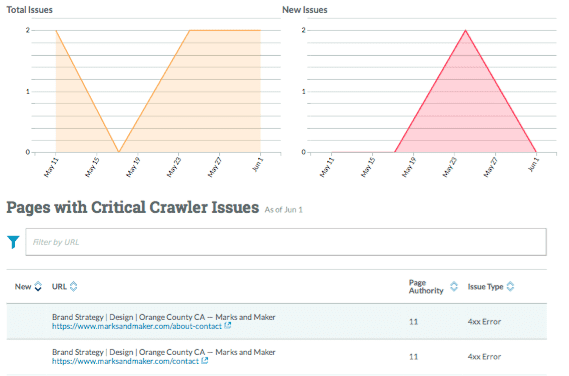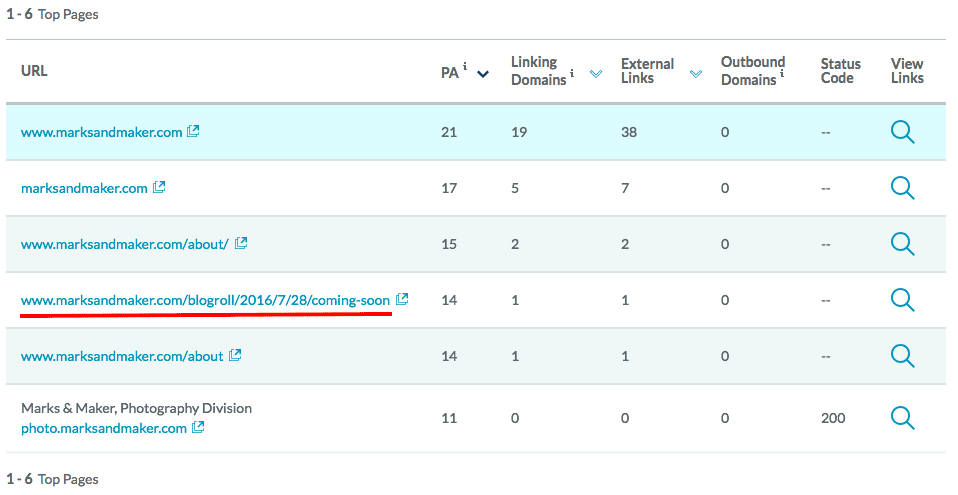In this vlog/screencast, we show you 4 SEO tactics to find and fix broken links…and how to set up redirects on a Squarespace website!
In case you would rather read a slightly modified transcript, we have included it below.
Melinda Livsey of Marks and Maker
Hi guys! It’s Matt from Cilderman Solutions. How are you? Good to see you, again!
So, today we are looking at Melinda Livsey’s website. She is the owner of Marks and Maker. You may recognize the name because she appears with Chris DO on The Futur’s YouTube channel, where she gets business coaching live. I believe the series she’s part of is called “The Process” and it’s pretty great!
You should check it out; it’s exciting to see over the months (and this is why they do it, obviously)… but it’s been exciting to watch over the past year, to see her grow, to see her revenue increase.
I said to her (Melinda) the other day; I feel like she’s becoming a mini Chris Do, like she’s starting to reach guru status on her own with the way that she’s thinking about her business and the deep insight she is having.
It’s exciting to see. If I can speak in chess terms, it’s like she’s starting to think a couple moves ahead and it’s just exciting to watch her grow.
I have to give her a lot of credit for putting herself out there on camera and being so open and transparent. I think that I would just sort of wither under Chris’s sharp questions, and I’d probably turn into a pool of mush. So, she does a great job there. Anyway, if you haven’t seen it, you definitely should check it out!
Broken Links and Redirects: SEO Process
Back to the task at hand: So, a couple of weeks ago, Melinda mentioned in one of her email newsletters (You should sign up for that if you’re not already a part of it. You’ll definitely get a lot of value from it). She mentioned that she had some broken links and me, loving search engine optimization, the gears in my head start turning (I guess that’s probably all I’ve got in their is gears). I start thinking, “OK. You know what? I want to run a ‘crawler bot’ on her website to find out what’s wrong.” So, I run a crawler and sure enough, she had two broken links.Then, I went to Melinda and I said, “I’d like to fix these for you” and so we kind of worked it out…And long story short, I asked if I could share the process with my viewers: Do a screencast of it and talk about my process to fix the links and redirects.
I hope that as you watch this, you’ll learn a little bit about how you could possibly fix broken links or, if SEO is just so far outside of your expertise, at least this will give you a little peek into my process.
If you’re gonna hire someone to do search engine optimization for you, sometimes we call that person an SEO, as well: a “Search Engine Optimizer” or a Search Marketer. So, if you’re gonna hire a Search Marketer, you’ll have some idea of what to look for depending on the services that they’re doing for you.
So we’ll talk about how we discover the broken links or the bad redirects and then I’ll show you on a Squarespace website because her website is on Squarespace. I’ll show you how to set up 301 redirects to basically fix the broken links.
So, just to reiterate. In case you haven’t heard of Melinda before, she does brand strategy, she does design and she’s based out of, I believe, Orange County, California. So, this is her website, here. I would encourage you to check her out. I believe that she’s very good at what she does and just based off of what I’ve seen on camera and the conversations that I’ve had with her, I highly recommend her.
Why Broken Links are Bad for User Experience and Search Engine Optimization
We first have to start with an understanding of why broken links are bad. Broken links are bad, not only because it ruins user experience, but it also hurts your search ranking in Google, OK?…and those two are closely related.
Let me talk about that for a second: User experience (UX) is very important because if you have these broken links, it’s funny that even though the user may be on your website and it may just take one extra click to get around that broken link,… it could be like that destination page is on the other side of the world. We are so used to instant gratification on the Internet. We don’t want anything getting in the way. Actually, people involved in user experience design often talk about the goal being to design a website so that it creates a “frictionless user experience,” so there’s nothing getting in the way of the user making a purchase or buying a product or something along those lines.
This makes sense if you think about it: We are all users on other people’s websites and we know that we want everything to go smoothly; we find it annoying, for instance, when a web page takes too long to load, right? We will go somewhere else.
So, user experience is very important. Like I said, if you want somebody to buy from you or hire you, you want them to be as happy as possible, having a great time. Also, sometimes broken links send a signal that implies a lack of professionalism or a lack of attention to detail. So it’s always good to just get rid of them.
This also relates to SEO in the sense that Google is interested in the user’s experience because Google will always be interested in providing the best results, solving the users’ problem as quickly and reliably as possible. Someone’s gonna search for something on Google and then hopefully your page will come up, if you’ve done your SEO correctly,…and then it’s your job on your website to solve the users’ problems quickly and the best way possible. Then Google will reward you with higher rankings.
If you are writing the copy for your website, designing the layout, or the “backend” technicals, like page speed….If you have done a good job with your user experience, that’s a good start and then there are a few more steps to making sure that your website interacts well with Google and Google’s bots. So, user experience is a big deal. It’s very important and then you go a couple steps further and you optimize for SEO.
The same thing is true for users and for Google. Google will look at broken links as a lack of attention to detail, a sign of lower quality. And so, in Google’s mind, your quality score drops a little bit (And we can get really technical and say that a broken link that goes nowhere is
worse than what they call a “soft 404”, which is a broken link that goes to a 404 page… but we don’t really need to get too deep into that). Either way, it’s not an ideal user experience and it’s not the best that you can do for your user…or to rank in Google results.
4 Ways to Find Broken Links.
Now that we’ve established that broken links are bad and talked a little bit about why they’re bad, let’s talk about how you find them. I already mentioned that I started by running a crawler bot on her website; that’s probably the easiest thing to do because you have the crawler do the work for you and discover the broken links. However, there are a number of other things that you can do to discover broken links.
1. Get a Crawl Report of the Website
First, I ran a crawler bot and found those two broken links (below). Basically, Marks and Maker, Melinda’s website, has gone through a couple different versions and that left, you can see there are 2 different versions of the Contact page: One was “/about-contact” and the other was just “/contact”. Now, the Contact page address is “/contact-form” and so these broken links go to a 404 page and they need to be fixed.
Something to note about crawlers: Often times a crawler will pick up broken internal links; however, it does not always pick up broken links coming into your website and so, there some ways that we can also look for that.

2. Using the Top Pages Report
One of the ways to help prioritize SEO tasks is to filter your crawl report by your list of top pages. Right now, I’m using Moz and Moz is pretty good. Yeah, there are some things that it could improve on but I would say I’m most comfortable with Moz.
So as I was going through the top pages, I found this broken link and you’ll notice that this is basically a “Coming Soon” blog post and it went to a 404 page ( see below). This is bad because you’ll notice it says under this column, here, “linking domains”. So, somebody is actually linking to that page that’s no longer there.

The Importance of Links in SEO
Let’s talk for a second about the importance of links from other websites in SEO. Let me see if I can explain this part clearly: Search engine optimization still has a lot to do with the importance of other people linking to your website, or to a certain page, and so it’s like a quality signal. When another website thinks your content is good enough to link to you, Google takes that as a quality signal and it usually means that your website or that page that has gotten a link, is going to rank higher in search results.
The problem with the way that this page was set up is, essentially, that the 404 page is getting the ability to rank and nobody wants that. You don’t want your 404 page showing up in search results. It’s kind of ridiculous! So, it’s a good thing that we caught this, and you’ll see later on, that I redirected it to the blog page, so that that would help her blogs rank higher.
So, the Top Page Report basically tells you the pages with the best ability to rank. it will also show you if they have links coming into them, which is one of the reasons that probably be ranking well.
So, we’ve covered two ways to look for broken links: The first one was to send a crawler bot, which is pretty easy. The second one is Top Pages Report and this can be harder to sort through if you have a bigger website.
3. The Wayback Machine
So, we’re gonna go to the Wayback Machine. I’ve had to use this a number of times. The Wayback Machine basically takes pictures of websites a couple times a month. So, you’ll see there’s kind of a timeline here, and you can see that Melinda first started a website in 2016 and what I noticed is that she has had a number of different redesigns over the years. There have been a lot of times when I’ve been brought in as an SEO (a Search Engine Optimizer or a Search Marketer) to fix issues where a web designer has just come and created a new website for somebody. Unfortunately, they did not understand SEO, and so the web designer just created a new website and they didn’t set up any redirects and there were a whole bunch of broken links.
Anyway, This could really, really take a long time if you decided to use The Wayback Machine and look at every single blog post and redirect every single blog post. However, what I’ll say is that one of the best things to do is to just maybe hit the pages in the main navigation to make sure that they redirect correctly or that the names haven’t changed.
Using this technique, I found, for instance, that Melinda no longer has a “Blog”. Now she calls it “Journal”. When I found this in here, I noted that I have to go back to the blog page and redirect it to the journal page. That was an important one because, obviously, you feature that in your main navigation and she blogs and she’s a good writer.
So, people will be following her and there’s the potential that some of the links would be broken and not work and so this is one of the ways that you can check previous versions of a website to see if anything was missed when the new website was created.

So, we went over three ways to check for broken links already:
- Crawler
- Top Pages Report
- Wayback Machine
4. Examine Your Analytics
The last one that you could possibly do is look in your analytics to see if your 404 page is coming up a lot or see if pages being visited that you know don’t exist. So, we’ve covered 4 good ways for you to find broken links.
Setting up 301 Redirects on a Squarespace Website
If you have Squarespace like Melinda, let me show you how to set up the redirects. In your Admin panel:
- Click on “Settings”
- Next, click on “Advanced”
- Then, “URL Mapping”
So, I actually typed the URL Mapping out in a Google doc because if you get anything wrong, it’s not going to work. So, you can just cut and paste it in. So the Squarespace URL Mapping is setup is like this: “/old-page -> /new-page redirect” . You put the type of redirect at the end. So, an example is “/blog -> /journal 301” This example uses a 301 redirect, which is a permanent redirect or transfer. You basically say to Squarespace and Google: “Anytime somebody tries to visit this page or you were gonna crawl this page, now you should crawl this new page, here, instead.In regards to URL Mapping: This is just how Squarespace takes care of redirects. If you have a WordPress website, I use Yoast premium… but there are other free plugins, so you don’t have to go and mess around in your hosting.
Recap and Closing
That’s the process for finding broken links. We talked about why it’s important to get rid of your broken links, and 4 ways you can find them. Also, how to set up redirects if you have a Squarespace website.
Alright, so please, if you have any questions, leave them in the comments and if you need anything, just reach out to me. It’s been fun. I hope you have a great night; take care!
